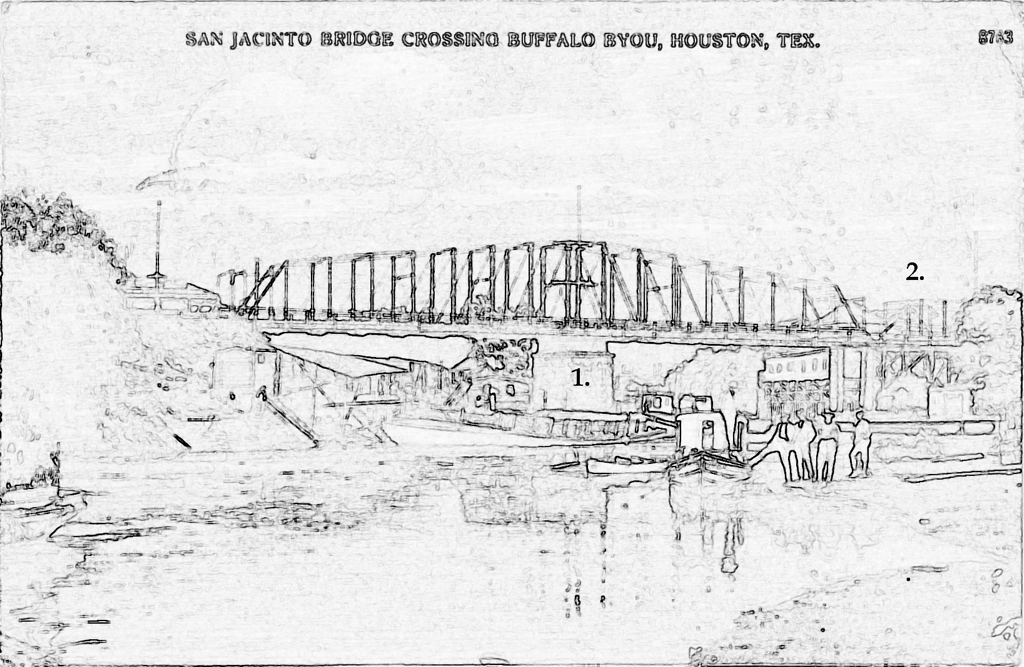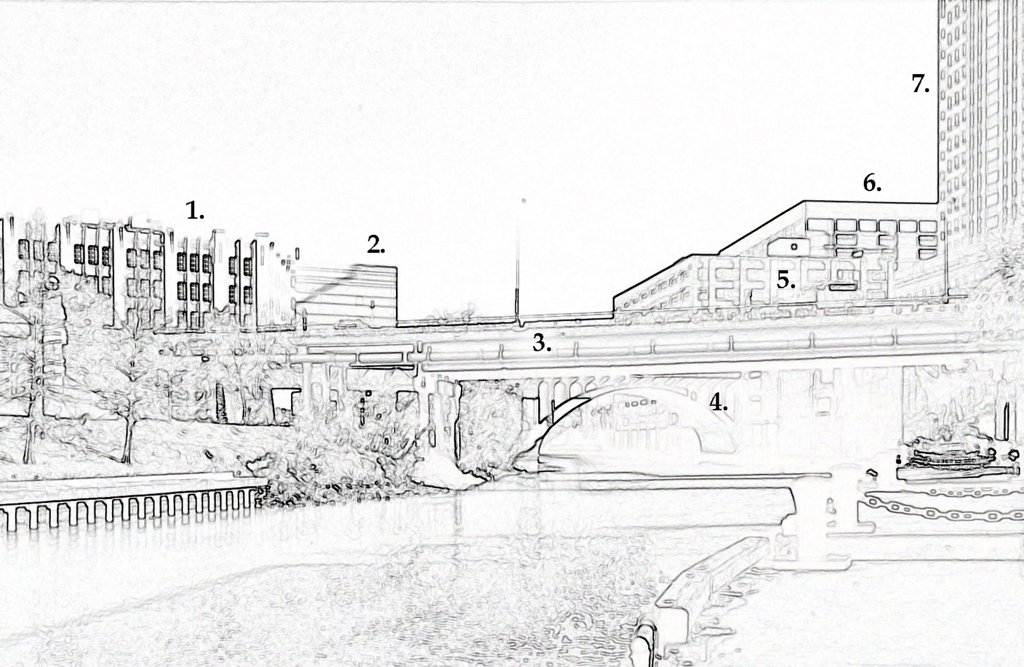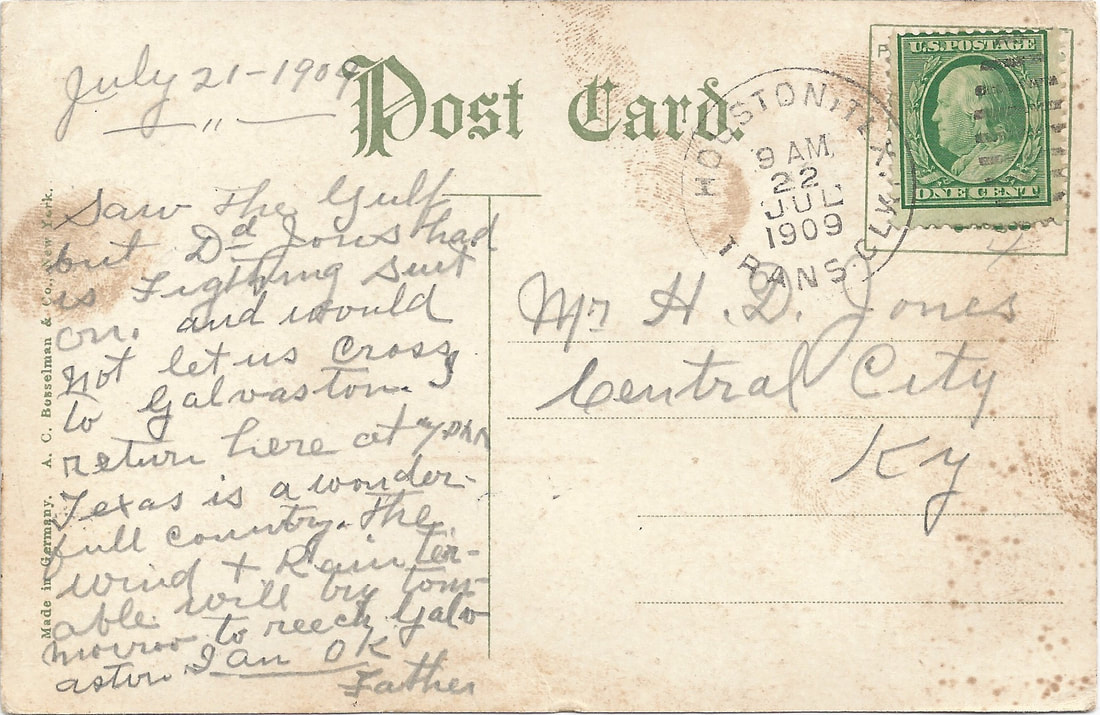San Jacinto Bridge
|
22 July 1909: 1. San Jacinto Street draw bridge; 2. Just beyond the bridge on the south bank of Buffalo Bayou at right were several low buildings: a) William J. Lemps Brewing Company at 1201-1203 Commerce, a Falstaff Brewing Company outlet out of St. Louis, MO; and b) The Schulte House, a waterfront hotel at 1211-1213 Commerce owned and managed by Otto H. Elbert.
|
17 January 2014: 1. 610 N. San Jacinto: Harris County Corrections Department - Annex #27 (Peden Company Building), 4 floors, 1930; 2. 1307 Baker: Baker Street Jail (Harris County Human Resources), 6 floors, 2002; 3. Fannin Street Bridge; 4. San Jacinto Bridge; 5. 49 San Jacinto: Harris County District Courts - Annex #21 Dispute Resolution Center (Wilson Building), 6 floors; 6. 1301 Franklin: Harris County Annex #22 (Harris County Jail), 13 floors, 1982; 7. 1201 Franklin: Harris County Criminal Justice Center, 21 floors, 1999.
|
|
To: Mr. H. D. Jones
Central City, Ky. Postmarked: 22 July 1909 Houston, Texas Trans. Clk. Message: Saw the Gulf but Dd Jones had us [illegible] on, and would not let us cross to Galveston. return here at 7 AM. Texas is a wonderful country. the wind and rain terable will try tomorrow to reach Galveston I am ok Father From: Father Notes:
|
September 21, 1909 saw the landfall of the first strong hurricane to come ashore at Galveston after the 1900 storm. It was called the Velasco Storm for its intersection with the coast, the historic town of Velasco. When Stephen F. Austin brought his colonists to Texas, it was at Velasco that the first colonists set ashore near the present day resort of Surfside, and it was through the port that 25,000 settlers eventually entered Texas. The Battle of Velasco in 1832 between settlers and the Mexican government preceded the Texas Revolution by four years, and the Treaty of Velasco established Texas Independence on May 14, 1836. The Confederate troops held the port through the Civil War, obliging Union ships to provision at New Orleans, but after the war ended, the demise of the plantation economy doomed the resort town. In 1891 Velasco was relocated inland, and the port was officially opened by United States Secretary of the Treasury, William Windom [lsee William Windom]. Years later, the Brazos River was rerouted and Freeport absorbed Velasco and the town of Quintana across the river.
The 1909 storm devastated Velasco and after the storm moved inland there were only eight buildings left standing. Forty one casualties were inflicted along the Upper Texas Coast, and there was considerable damage to the port city of Galveston, although the newly constructed seawall and grade raising spared the city from the enormous casualties of the 1900 storm. [See German Lutheran Church for another postcard in this series with a connection to this storm.] It is unclear what the father of H. D. Jones was doing on the coast, he was after all from Kentucky and may have been in the area and only incidentally decided to help out. He mentions Dd Jones, and the fact that the latter seems to have been in charge of an expedition to cross the bay into Galveston. Dd Jones may have been a relation, but his identity has not been determined. The author directs his postcard to his son, H. D. Jones of Central City, a small town in central Kentucky, but one of the largest coal mining districts in the country. It was the coal industry that initially drew H. D. Jones’ father, William Jones, to the area around central Ohio from a similar coal district in Wales. William Jones was born September 13, 1853 in South Wales, and in 1882 he and his son Hywel came to America on the S. S. Arizona when Hywel was about five years old. They settled in Muhlenberg County, KY, where William worked as a mine foreman. It is not certain what happened to Hywel’s mother, whether she stayed behind or had already died by the time the family came over, but about 1900 William married Lucy Ann Stroud, born in 1864 in Kentucky. At this time Hywell, who began to call himself Howell to avoid confusion by those unaware of Welsh naming conventions, worked as a engineer in the mines and lived in nearby Ohio County, KY adjoining Muhlenberg County. On January 18, 1898 in Central City he married Ester and on August 14, 1900 they had a son, William Gaddis Jones. In 1910 Howell and his father were both together again in Central City, but on 20 October, 1915 William died of stomach cancer by which time Howell Jones had moved to Chicago where he worked as a stationary engineer. William was buried in Fairmount Cemetery in Central City, KY. Howell Jones stayed in Chicago and by 1940 he was a widower working as an engineer at a hotel, living with his unmarried son William, 39, who worked at the hotel as a cook. In 1946 Howell received his naturalization papers, and in 1947 his stepmother Lucy Ann, died and was buried beside his father in Ohio. It is not known when Howell or his son William died. |



